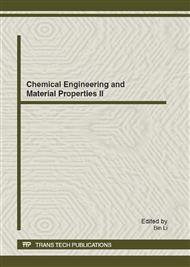p.50
p.54
p.60
p.65
p.70
p.74
p.78
p.82
p.87
Dyeing Acceleration Theory of Molecule Companion on Silk with Reactive Dyes
Abstract:
In this paper, a novel high efficient dyeing acceleration theory of molecule companion(DATMC) on silk with reactive dyes was invented and studied. Organic cations were used as accelerants to company reactive dyes to dye on silk, and the dyed silk was washed with anionic surfactant. The results showed that the dye-uptake rates were very high, nearly 100%. But if the carbon atom number of hydrophobic hydrocarbon chain of organic cation was equal to or more than 12, the organic cation would affect the fixation reaction of reactive dye on silk. On the contrary, if it was equal to or less than 8, the fixation reaction would be accelerated. The fixation rates were 98.10% and 98.48% with octyl trimethyl ammonium bromide(OTAB) and hexyl butyl dimethyl ammonium bromide(HBDAB) as accelerants, respectively. The fastnesses of dyed silk were 4-5, and the silk could be dyed uniformly if the accelerant was added in several times.
Info:
Periodical:
Pages:
70-73
Citation:
Online since:
July 2012
Authors:
Keywords:
Price:
Сopyright:
© 2012 Trans Tech Publications Ltd. All Rights Reserved
Share:
Citation:


